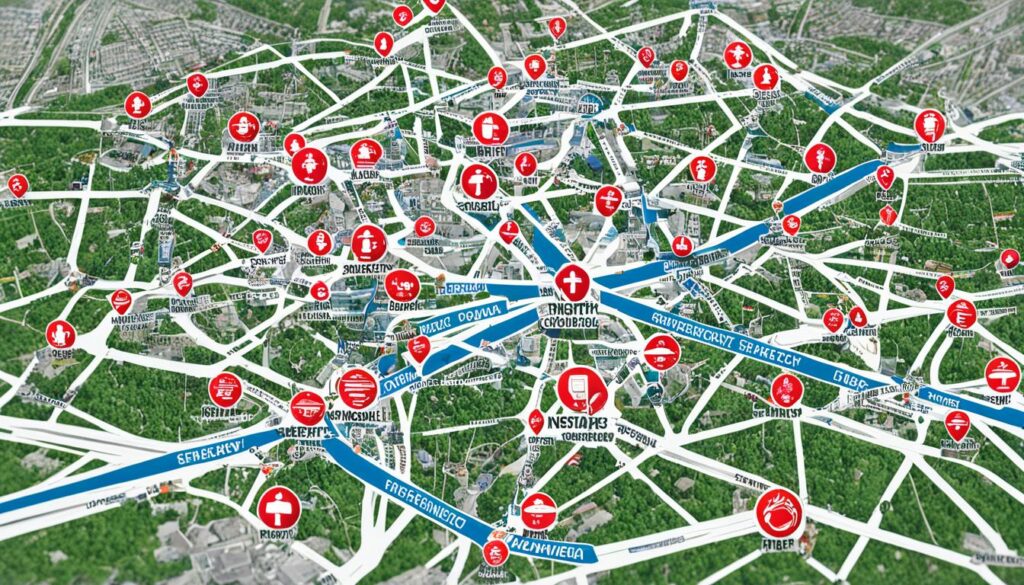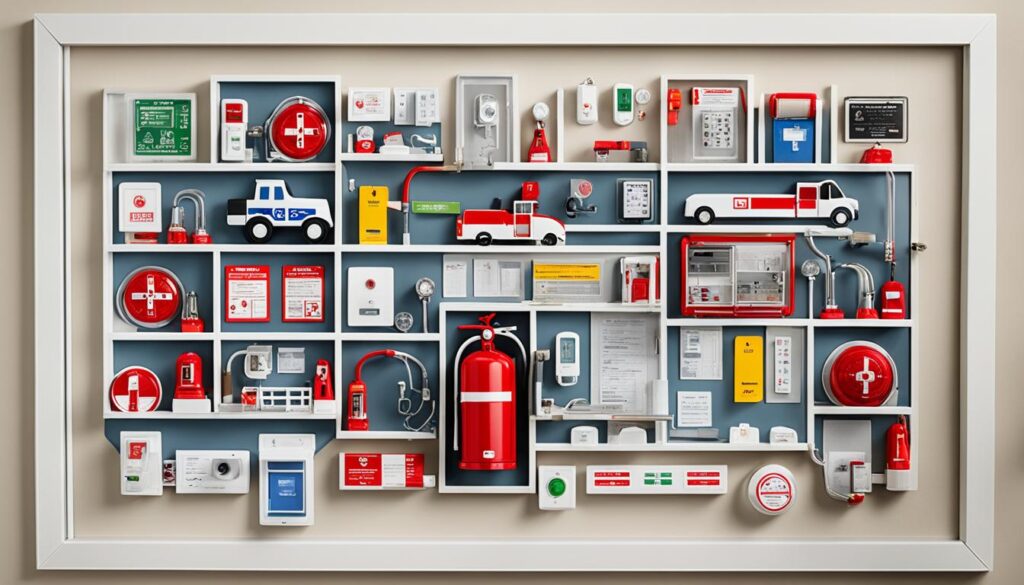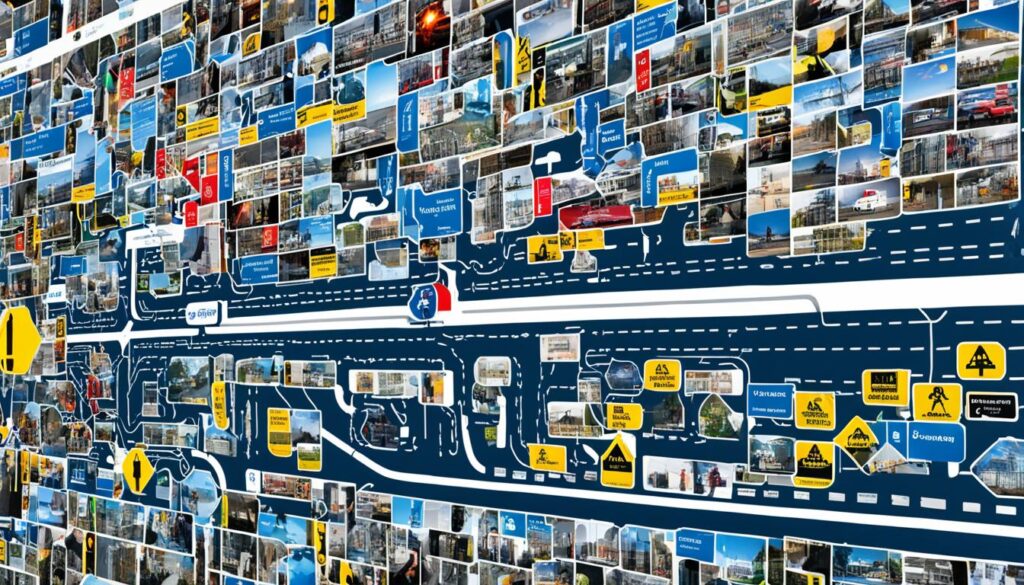In our ever-changing world, a strong safety network is key. This guide will show you how to set up a dependable support system. You’ll learn who to call in different crisis situations. By the end, you’ll be prepared with a network that offers comfort and help when it’s needed most.
Key Takeaways
- Establish a safety network to ensure you have the right contacts in case of an emergency.
- Identify key contacts, including family, friends, and medical professionals, to build your support system.
- Create an emergency action plan to ensure your network is informed and ready to assist when needed.
- Regularly update your contact information to maintain the effectiveness of your safety network.
- Utilize technology and community resources to enhance the strength of your safety network.
Importance of Having a Safety Network
Emergencies come when we least expect them. It might be a natural disaster, a health crisis, or personal issue. A strong safety network helps you be ready for anything. It gives you peace of mind and ensures you have help and resources when needed.
Emergencies Can Strike Anytime
Emergencies do not pick favorites. They can hit anyone, anywhere, at any moment. Having a safety network ready is key. It means being quick to respond and with a plan that protects you and your family from harm.
Peace of Mind from Preparedness
With a solid safety network and a plan, facing emergencies is easier. You know you have support and resources close by, which brings big peace of mind. This readiness lowers stress, enabling clear thinking and better choices during hard times.
“Being prepared doesn’t mean living in fear. It means living in safety.”
Build a thorough safety network for you and your family. Find and connect with important people now. This step means you’re not alone when the unforeseen happens.
Identifying Key Contacts
To build a strong safety network, you first need to know who your key contacts are. Think about your closest family, friends, and essential medical folks. These contacts are vital for feeling secure and ready for any surprise event.
Family and Close Friends
Your family and friends are the core of your safety net. List your spouse, kids, and parents’ contacts first. Don’t forget a few close friends. They offer support, help with kids or pets, and with tasks like driving or shopping.
Medical Professionals
Don’t overlook your medical support team. Keep your doctor, specialists, and the nearest hospital’s numbers handy. In emergencies, reaching out to these medical professionals can offer quick help and advice.
Organizing your key contacts helps you create a strong safety network. This network is there to support you in rough times.
“In an emergency, having a well-established safety network can make all the difference in minimizing the impact and ensuring a swift and effective response.”
Establishing a Network
Creating a strong safety network is vital for your protection in tough times. Start by listing your main contacts. This includes family, friends, and doctors you trust. Next, set up your list. Write down their details and what they can do to help.
First, get the phone numbers and emails of people close to you. This means family, best pals, and trusted health experts. Save this info in one place. A notebook or computer file works well. It helps a lot in an emergency.
Think about what each person can offer. A friend might help you calm down and open your door if you lose the keys. Someone living nearby could keep an eye on your home. Make sure each person knows what they should do in an emergency.
- Get and list the phone numbers and emails of your main contacts.
- Decide what each person’s role will be in an emergency.
- Check and update your contact list regularly.
“The greatest weapon against stress is our ability to choose one thought over another.” – William James
Making a smart safety net gives you peace of mind. It means there’s help ready when you need it. Being ready this way can greatly reduce the trouble of an emergency. It keeps you safe.
Creating an Emergency Action Plan
Now, let’s make an Emergency Action Plan. We will gather important info and make sure everyone knows what to do. Being prepared helps keep our loved ones safe in tough times.
Gathering Essential Information
First, list important details for emergencies. Write down contact numbers, medical info, and how to leave your home. Keep this list handy and update it when needed.
- Emergency contact numbers for police, fire department, and medical services
- Contact information for close friends, family, and trusted neighbors
- Copies of essential papers, like insurance, health records, and money info
- Plans for leaving your home, with different ways out and where to meet
Sharing the Plan with Your Network
Now, share your Emergency Action Plan with those in your Safety Network. Make sure everyone understands what to do during emergencies. Keep talking and updating the plan together.
“Making a plan is the start of staying strong in tough times. A good Emergency Action Plan helps protect your family and community.” – Jane Doe, Emergency Preparedness Expert
Don’t forget, talking and working with your Safety Network is key. Together, you can face any emergency better.

Maintaining Your Safety Network
It’s key to keep your safety network up to date for emergencies. Since we all change over time, regularly review and update your network. This keeps it ready when you need it most.
Updating Contact Information Regularly
Phone numbers, addresses, and people around us often change. To stay on top, review your key contacts’ info every six months. Make sure to update details for:
- Family and close friends
- Doctors and health providers
- Emergency responders like police and ambulance
- Utility companies and local authorities
By updating this info, you ensure quick access to help when necessary. This action boosts your preparedness and calmness.
“Preparedness is the foundation of a strong Safety Network. By keeping it up-to-date, you’re ensuring your network is ready to support you in any situation.”
It’s also smart to look over your emergency plan from time to time. Check and update the steps you’ve set. This makes certain everyone in your network knows what to do.
Keeping your Safety Network in shape is an ongoing effort. The peace of mind and security it brings during hard times are worth the small effort. By doing this, you safeguard yourself and your loved ones.
Home Safety Measures
Ensuring your home is safe is a key part of your Safety Network. It’s vital to take steps to make your home secure. This effort boosts your readiness and offers a feeling of safety for your family.
Setting up smoke detectors is a basic step for home safety. These devices warn you about smoke or fire. This early warning gives you time to leave the house. Remember to check and keep your detectors working well.
Having fire extinguishers in easy reach is also essential. Put them in places like the kitchen and hallways. Knowing how to use them is crucial. Don’t forget to inspect and keep them ready for use.
- Make an emergency action plan for your home. This should include safe places and how to leave during emergencies.
- Put together a disaster preparedness kit. Include things like first aid, flashlights, and food that won’t go bad.
- Think about security systems or lights that turn on with movement. These can make your home safer from break-ins.
Adding these safety measures to your plan can greatly improve your family’s safety. They lower the risk of getting hurt during an emergency.

Network for Workplace Emergencies
Building a solid safety network for workplaces is crucial. You must be ready for any emergencies that could happen. Knowing what to do can keep you and your colleagues safe.
One crucial part of this safety network is having key contacts at work. These might be your boss, HR team members, or special crisis response staff. Know your workplace’s emergency plans and who to contact. Keep all this information handy.
It’s also important to keep in touch with your coworkers. Talk about what you should do in an emergency. This builds teamwork and makes sure everyone knows how to react if a crisis hits.
Remember, having a strong safety network matters not just for you, but for the whole workplace too. By spending time to establish and uphold this network, you will feel more ready for anything that comes your way. This brings you peace of mind.
“A strong safety network is not just a luxury – it’s a necessity in today’s fast-paced, ever-changing world. Investing in your own preparedness can make all the difference when the unexpected occurs.”
So, make sure your workplace has a strong safety network. Your peace and your coworkers’ safety rely on it.
Building a Community Network
It’s vital to expand your safety connections. Try getting involved in local Neighborhood Watch programs. These programs help make your area safer.
Neighborhood Watch brings people together to prevent crime. You get to know your neighbors better and make your community safer together.
Neighborhood Watch Programs
Neighborhood Watch usually includes:
- Meetings with neighbors to talk about safety
- Talking to the police about any safety issues
- Setting up a fast way to share emergency info
- Checking for safety issues and adding security to the area
- Holding events to make everyone feel part of the community
Joining this program is good for your own safety and the whole community. It lets you meet new people and work on safety together.
“A thriving community is built on the foundation of a strong safety network.”
To find out more, talk to your local police or community groups. Joining can help make your community and neighborhood better for everyone.
The Role of Technology in Your Safety Network
In today’s world, technology plays a big part in keeping us safe. It offers many ways to stay in the know during emergencies. For example, advanced alert systems and user-friendly mobile apps are ready to keep you connected and informed.
Imagine your house is always keeping you up-to-date. Smart home gadgets let you watch over your place from afar. They also send alerts or let you control things if something goes wrong. Plus, apps for emergency alerts keep you warned about dangers like natural disasters or if there’s a threat to public safety.
Also, talking with loved ones or health experts is easier because of video chats and messaging. These tools help you quickly talk, share what you know, and offer help when it’s needed most. They make sure you can get and give support no matter where you are.

